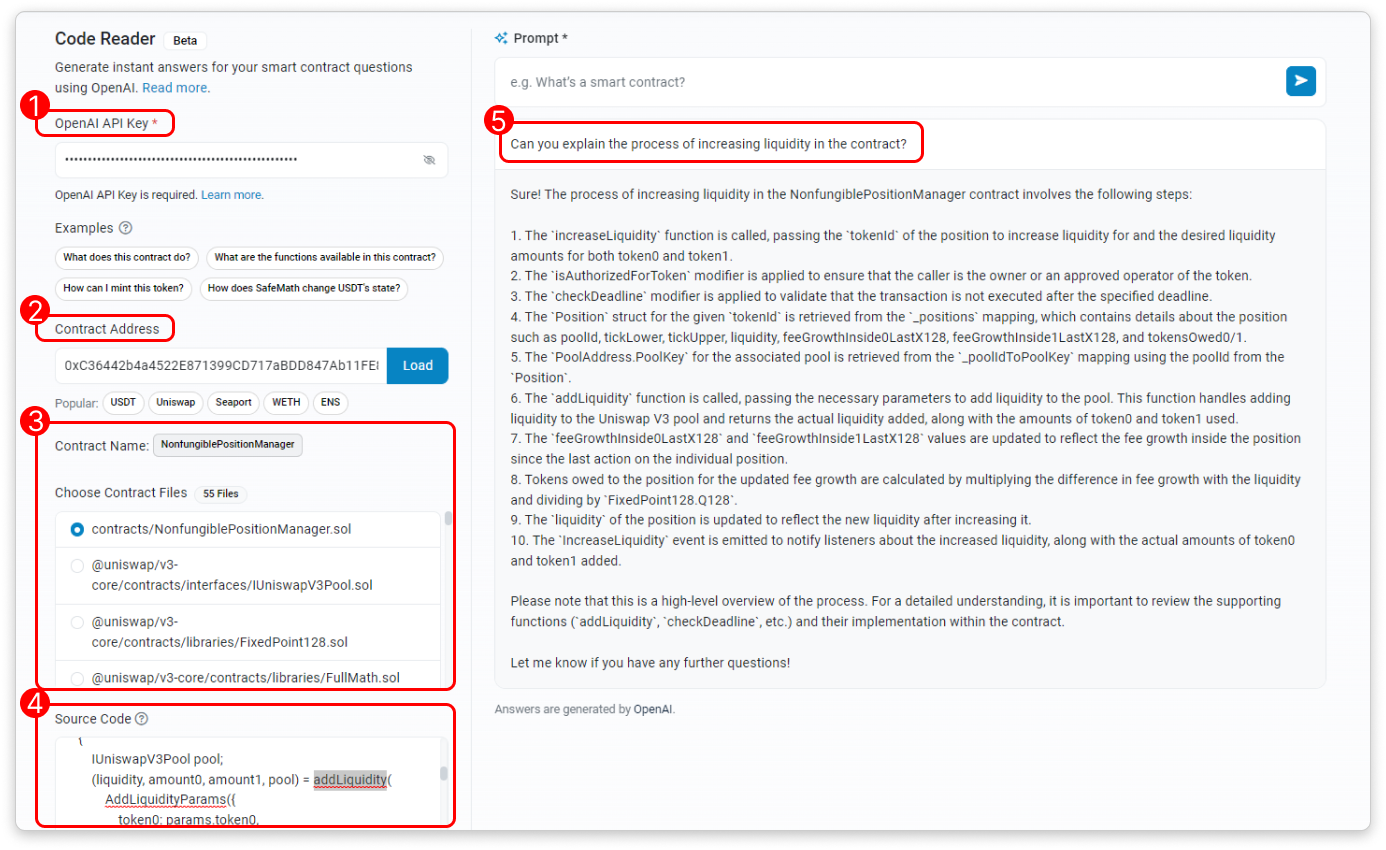Code Reader
Note: Moonriver (MOVR) on Kusama is a companion network to Moonbeam and provides a permanently incentivized canary network. New code ships to Moonriver first, where it can be tested and verified under real economic conditions. Once proven, the same code ships to Moonbeam on Polkadot.
Polygon PoS (polygonscan.com) is an EVM-compatible environment optimized for high throughput and low transaction fees while Polygon zkEVM (zkevm.polygonscan.com) is an EVM-equivalent ZK rollup designed for security.







The Code Reader is a tool that leverages the power of AI to provide users with the ability to retrieve and interpret the source code of a specific contract address. By selecting a contract address, users can access and interact with the contract's source code files. This article will guide you through the process of using this tool and highlight some use cases.
The Code Reader is a tool that leverages the power of AI to provide users with the ability to retrieve and interpret the source code of a specific contract address. By selecting a contract address, users can access and interact with the contract's source code files. This article will guide you through the process of using this tool and highlight some use cases.
The Code Reader (Polygon PoS / Polygon zkEVM) is a tool that leverages the power of AI to provide users with the ability to retrieve and interpret the source code of a specific contract address. By selecting a contract address, users can access and interact with the contract's source code files. This article will guide you through the process of using this tool and highlight some use cases.
The Code Reader is a tool that leverages the power of AI to provide users with the ability to retrieve and interpret the source code of a specific contract address. By selecting a contract address, users can access and interact with the contract's source code files. This article will guide you through the process of using this tool and highlight some use cases.
The Code Reader is a tool that leverages the power of AI to provide users with the ability to retrieve and interpret the source code of a specific contract address. By selecting a contract address, users can access and interact with the contract's source code files. This article will guide you through the process of using this tool and highlight some use cases.
The Code Reader is a tool that leverages the power of AI to provide users with the ability to retrieve and interpret the source code of a specific contract address. By selecting a contract address, users can access and interact with the contract's source code files. This article will guide you through the process of using this tool and highlight some use cases.
Disclaimers:
Before we proceed, here's a few things you need to know:
- AI-generated answers: The responses are generated by OpenAI's large language model (LLM) and are for informational purposes only. Always verify their accuracy and do not rely solely on them as evidence or for bug bounty submissions.
- Generating prompts: To use the tool, you need a valid OpenAI API Key and sufficient OpenAI usage limits. This tool does not store your API keys.
- Chat completion mode: The tool currently supports only one-off prompts and does not allow for continued conversation threads.
Code Reader Walkthrough






- Start by entering your OpenAI API Key.
- Paste the contract address you wish to explore.
- The tool will automatically fetch all the files associated with the provided contract.
- Once the contract files are retrieved, you can choose a specific source code file to read through. Additionally, you may modify the source code directly inside the UI before sharing it with the AI.
- Based on the selected source code, you can generate AI prompts to interact with the code and ask questions to gain a deeper understanding.
examples to get an idea of how it works.Example Use Cases:
- Code overviews: Gain deeper insights into the code by generating AI prompts for specific code sections or functions that you want to understand better. Utilize targeted questions to get AI-generated explanations, enabling you to delve into the inner workings of the code. This feature is particularly valuable when interacting with a smart contract for the first time, as it provides a thorough understanding of its operations and functionality. Additionally, leverage this capability to generate documentation for reference purposes.
- Retrieve read/write functions: Obtain a comprehensive list of smart contract functions related to reading and writing Ethereum data, along with detailed explanations of their respective functionalities. With this information, you can make informed decisions on how to interact with these functions directly on the respective contract address page, under the Read Contract or Write Contract tab.
- Exploring dApp integrations: Dive into the code to gain a comprehensive understanding of how to seamlessly integrate the selected smart contract with your decentralized applications (dApps).
Limitation on Proxy Contracts:
When you paste a proxy contract address, the tool will not automatically retrieve contract files of the implementation contract. To access the relevant implementation contract, you can go to the proxy contract's address page, check the "Read/Write as Proxy" tab and copy the address:

If the "Read/Write as Proxy" tab is not available, you can navigate to the button below, click "Verify" on the Proxy Contract Verification page, and copy the implementation address found:


Your Feedback Matters!
We highly value user feedback to enhance our tool's capabilities and address any issues. Please provide your feedback to help us improve the Code Reader during this beta release.
